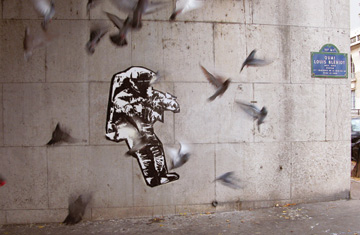
ONE SMALL STEP FOR GRAFFITI: Spaceman by Blek le Rat, who pioneered the popular stencil technique
It's official: street art "is part of the zeitgeist," says photographer and art historian Fabienne Grévy. Just look at the six-figure prices of works by British graffiti artist Banksy at recent London auctions. They show an enormous leap — from ostracized to respectable — for the most subversive of art forms. But ask Banksy who blazed the trail, and he'll point across the Channel: "Every time I think I've painted something slightly original, I find out that Blek le Rat has done it as well. Only 20 years earlier," he once said.
In 1981, Blek pioneered the technique of pochoir, or stencil graffiti, to place his signature rat on walls around Paris, signaling a break with the dominant letter-based New York style of tagging and the birth of the post-graffiti movement. In the following decades, French artists such as Blek, Jef Aérosol, Miss Tic, Nemo and Jérôme Mesnager quietly developed their brand of edgy, visual urban poetry, earning them devotees and imitators around the world and spurring an explosion of books on their oeuvres (see our guide).
Just like many famous French painters before them, France's street artists at first struggled for recognition in their own country. "Who bought the Impressionists?" asks Anne Vignial, owner of Galerie Anne Vignial, the first Paris gallery specializing in urban art. "Not the French — the Americans and the English." Now that's changing. Paris auction house Artcurial sold $726,500-worth of street art in February, including works by Jef Aérosol, Miss Tic and Blek. But much of this art can be seen for free. Paris' urban landscape is the great museum of street art — always open to visitors — where, as Grévy recounts in her book Graffiti Paris, "a new page of contemporary art history" is written daily. Here's where to read about, and see, the very best.
Nemo by Daniel Pennac
French writer Pennac pays tribute to Nemo, who for years has "projected onto our walls the never-ending film of his dreams." Pennac's favorite is the stunning work on Rue Pirandello, where Nemo's Humphrey Bogart-like shadow chases cats down the still-visible outline of a stairway from a long-ago demolished building.
Blek le Rat: Getting Through the Walls by Sybille Prou and King Adz
This is the first book solely devoted to Blek. At the Artazart gallery, 83 Quai de Valmy, there are several of the artist's iconic pochoirs, including The Man Who Walks Through Walls, who, like Blek, carries his stencil-filled suitcase the world over.
Il Court Toujours... 25 Ans by Jérôme Mesnager
On the cover is Mesnager's ethereal white figure Le Corps Blanc who, for the past 25 years, has been running across walls — from Paris to Pondicherry, Marrakech to Saigon and back to Paris' Belleville, where the giant mural of dancing men and women at 68 Rue Menilmontant symbolizes solidarity for this hardscrabble neighborhood.
Miss Tic in Paris by Miss Tic
The first complete monograph on Miss Tic, who in 1985 adopted the pochoir technique for her stylized self-portraits and clever aphorisms. She lives in the Buttes aux Cailles neighborhood, and her local stencils include one at 23 Rue des Cinq Diamants, where a tough-looking mini-skirted mademoiselle breathes, "What wasn't given to me, I took."
VIP: Very Important Pochoirs by Jef Aérosol
Just up the street from Miss Tic's bad-ass alter ego, a curious accordion player by Jef Aérosol grins out from the brickwork. Since 1982, the master of stencil portraits has depicted musicians — many of whom appear in this book — from Elvis, Bob Dylan and Sid Vicious to a street-corner fiddler, all expressing his leitmotif: "Music softens the walls."